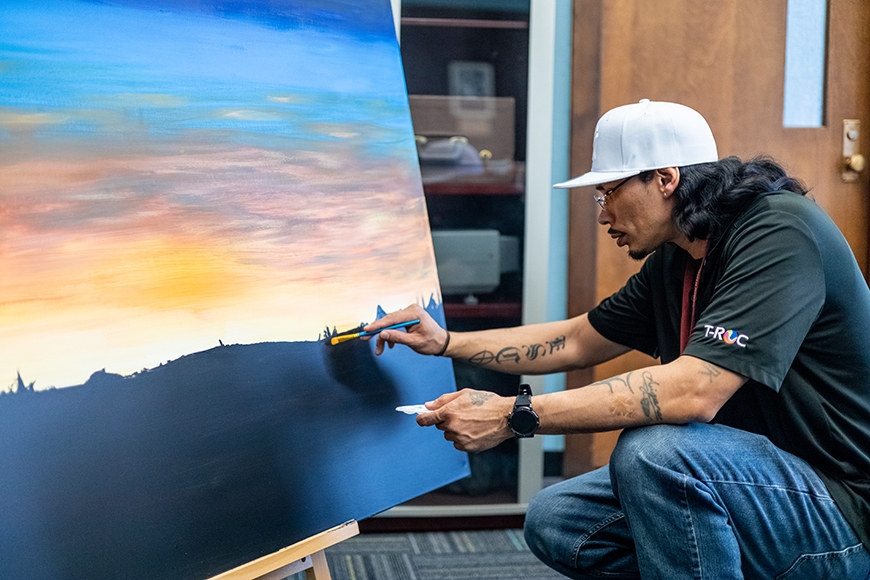Patrick Blanchard: Creating Community Through Art
“If I wasn't able to be a resident artist, I would definitely not be able to introduce my style of artwork or meet the people that are involved in U of M,” says Patrick Blanchard, an emerging artist and painter in the Department of Chicano & Latino Studies’ (CLS) Artist in Residence (AIR) program. Funded by the College of Liberal Arts, the program invites a local artist from outside of the University’s campus to develop their craft in a semester-long residency as a way for the University to engage with the community.
"With the AIR program, CLS is able to actualize the original vision of Chicana/o/x and Latinx studies as a truly interdisciplinary field and recognize the arts as a critical component of our interdisciplinarity," says Karen Mary Davalos, a professor in the CLS department.
Blanchard is the fourth artist to take part in the program and the first to participate at the beginning of his art career. Having both Puerto Rican and Indigenous (Ojibwe and Oneida) heritage, Blanchard hopes that his art can inspire others and spark conversation.
Embracing Art as a Career
Since childhood, Blanchard has had a passion for art. However, it wasn’t until he was given the opportunity to create a mural for the University of Minnesota’s American Indian Student Cultural Center (AISCC) in 2018 that he began to consider turning his hobby into a career. Creating such a large work that could be seen by many people gave him the motivation to take his art more seriously. He saw it as a way to increase visibility for Indigenous people and to prove these cultures have always existed.
“My artwork is based on Indigenous culture in North and South America, because I have both sides in me,” Blanchard says. “My culture is really beautiful, and the stories and the people and the colors and the traditions are something that I really like sharing with others.”
Blanchard found out about the artist residency program through a friend and immediately knew it was the path he wanted to follow. Becoming a part of the University’s large community gave him a chance to connect with and learn from other artists and to share his own work with a broader audience.
Creating a Calm Space for Painting
As an emerging artist, Blanchard has obligations outside of his artwork. But after busy days of balancing his residency, family life, and full-time job, he finds painting to be a therapeutic way to unwind. This relaxation technique sparked his idea of hosting painting workshops for undergraduate students, giving them a chance to put their studies aside for a couple of hours and reconnect with their creativity. The workshop is available for students of all majors and is all about creating a positive atmosphere for students to connect through art.
“Students just need to have time to relax and enjoy what they're doing without any distractions. I hope to bring to the campus with these workshops a feeling of peace and relaxation that shows students another way to breathe,” Blanchard explains.
True to his vision, the workshop is purely about painting. Students start out with a blank canvas still in its wrapping, an empty palette, and a set of paintbrushes. Blanchard asks students to think about what makes them the most happy and create whatever best represents that. Other than that, it’s entirely at the students’ own pace. They choose what they want to create, from the composition of the painting to the colors they use. Blanchard is there to observe the art process and give advice when needed. Reggae music playing in the background adds the final touch to the calming environment.
The workshops have been a success. Students enjoy making time to paint, and Blanchard loves to help rekindle participants’ love of art.
“I'm really glad that everyone liked the workshops," Blanchard expresses. “The only thing people wanted different was more time.”
A Painting That Surpasses Borders
With his residency nearing its end, Blanchard is set to present his artwork in the fall of 2023, with a focus on how political borders shape the way Indigenous people are viewed. He emphasizes how the same people and the same cultures still exist despite the belief that they disappeared with the forming of borders. His painting conveys a voluminous sunset with a landscape filled with various tribes and nations across the Americas.
“People tend to think that South American Natives and North American Natives aren't still the same people because of the borders that were put up when colonization started. But that landmass has always been there, and the people have always been together,” says Blanchard.
The residency is just the beginning of Blanchard’s art career. He wants to do it full-time, teaching art classes and taking on new projects. Above all, he wants to be involved in the Minneapolis community and share his voice.
“I get inspired [by] listening to other people talk about their artwork,” explains Blanchard. “[Being here] means that I'm able to have a broader audience for getting the word out about my culture. Just being able to be part of a community—that's a beautiful thing.”


